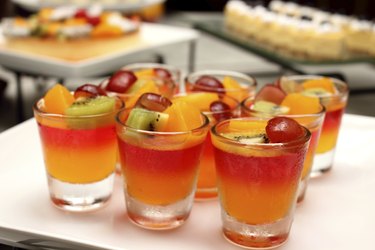
Fruit pectin and gelatin can both be used to thicken, jell and set certain foods, but there are some important distinctions between the two. They come from very different sources, so they have different nutrients as well as health benefits. In addition, they can have different applications in food preparation and manufacturing.
Pectin and Plants
Video of the Day
Pectin is a carbohydrate substance derived from plants, usually fruits. It's found in the plant cell walls and often binds cells together. Most fruits and some vegetables contain pectin, but apples, plums, grapes and citrus fruits like grapefruit, oranges and lemons are the best sources of pectin. Its concentration is highest when the fruit is at the just-ripe stage. Most commercial pectin is made from apples or citrus fruits.
Video of the Day
Gelatin Production
Vegans and vegetarians should be aware that gelatin is produced from animal-based proteins, specifically collagen, a protein found in meats, bones and animal skins. Gelatin dissolves when heated and congeals when cooled, which allows foods to set. Most commercially manufactured gelatin is made from pigskin in the United States or cattle in parts of Europe. Agar is a vegan alternative to gelatin and is made from seaweed.
Nutrition Facts
Because they're derived from different sources, gelatin and pectin have completely different nutritional profiles. Pectin is a carbohydrate and also a source of soluble fiber -- the type that can reduce your cholesterol, stabilize your blood sugar and help you to feel more full. According to the U.S. Department of Agriculture, a 1.75-ounce packet of dry pectin has about 160 calories, all from carbohydrates. Gelatin, on the other hand, is all protein, and a 1-ounce packet has about 94 calories. The Gelatin Manufacturers Institute of America states that gelatin contains 19 amino acids and all of the amino acids essential to the human body except for tryptophan.
Different Food Applications
Gelatin is commonly used to jell dairy products like sour cream or yogurt, and in foods like marshmallow, icings and cream fillings. It's also used to jell meat juices, as in canned ham, and you've probably eaten gelatin in its most popular form, Jell-O. Pharmaceutical companies commonly use gelatin to produce capsules for medicines. Pectin can be used in similar dairy and bakery applications, but because it requires both sugar and acid to set, it's more often used to jell fruit mixtures like jams.
- Encylopedia.com: Pectin
- National Center for Home Food Preservation: Making Jams and Jellies
- Encyclopedia.com: Gelatin
- Gelatin Manufacturers Institute of America: FAQ
- Gelatin Innovations: Uses of Gelatin
- International Pectin Producers Association: Applications of Pectins
- University of Colorado Colorado Springs: Soluble Fiber vs Insoluble Fiber
- USDA National Nutrient Database: Pectin
- USDA National Nutrient Database: Gelatin